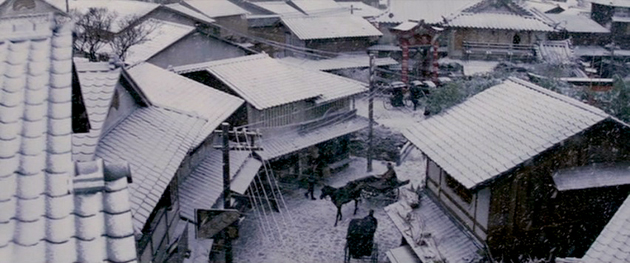John Myhre

We had twenty-four foot tall cherry trees all along our riverbank and all through the city and we actually made four sets of these matching cherry trees. So we had the spring cherry trees which were all in the beautiful cherry blossoms, and we had our summer trees with green leaves, we had our fall trees with the beautiful fall colors, goldens and oranges, then we had the bare-limbed trees that you’d see in winter. And they were all on big bases and they all had crane hooks in them and when we’d get the call-sheet and see what we were shooting the next day, what season it was, at night-time two or three cranes came in and would lift these giant trees out and carry them through the set and bring the correct season in.
And then a lot of things that could be man-handled by people were moved around and we redressed. They actually changed the type of screens on houses for different seasons in Japan so there are even architectural changes we made constantly throughout. The schedule was never really set up in such a way that you could shoot one season out and move to another. We had to be very flexible and it was really fun.
It was amazing watching the crew’s face when they walked into the set because it was the size of about two football fields and it was all designed in a very maze-like pattern. It was like building an old-fashioned back-lot. We didn’t want to have any straight streets where you’d shoot off and need a blue-screen in the end. We made everything very curved and maze-like. Which became again part of the design of the film where you never know what you’re really seeing and things are masks. So when you walked into the set you could actually walk for about five minutes through the various alleyways and streets and never leave a three-hundred-and-sixty degree world.
We had a two hundred-and-fifty foot long river that actually recycled its water so that you could throw cherry blossoms at one end and they would float through and come back around. We could also raise and lower it for the different seasons. Rainy season it was up high, eight feet, and other times it was down to just six inches. So the whole thing was super-flexible.
Dion Beebe, who is an amazing cinematographer, was thrown the challenge of the seasons as well. We were shooting in California in the summer which is constant California summer light but we needed to do fall and winter, with very flat winter light. So he devised the biggest silk that was ever used in Hollywood. The silk was basically two football fields. You could never make one piece of fabric that big because one piece would just be uncontrollable. It’s like a ship’s sails in a funny way. So he and his key grip devised a very simple idea where he took that whole field and divided it into twenty-five by two-hundred-fifty foot strips and ran cables between each of them so the silk was actually composed of all these little fingers that could be pulled across individually. So you didn’t have to use all of it, you could use part of it. When the winds kicked up, as they did, that made it much more manageable. We lost a couple pieces of silk in the course of the shooting but it really did the trick.
AS: How long did it take to build the village and about how many people did it take?
JM: It physically took sixteen weeks to build and we had about three hundred people working on it. And true to the way movies go you never really have enough time in prep. You really can’t just go start building a city without having done a lot of drawing. And we did not get an official green-light on the film until about fourteen weeks before principal photography so I wasn’t able to put on a big crew until about fourteen weeks before we started shooting.
Pingback: David Warren
Pingback: Jess Gonchor
Pingback: David Wasco & Sandy Reynolds-Wasco